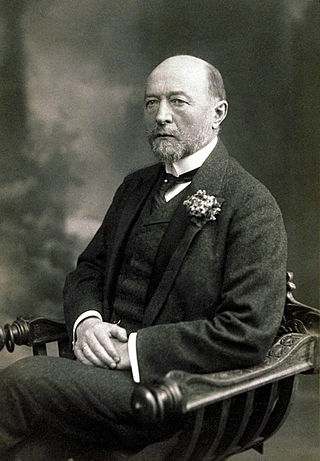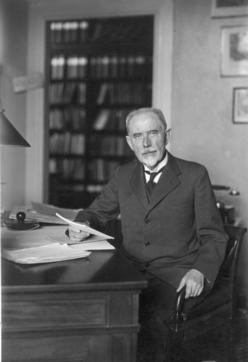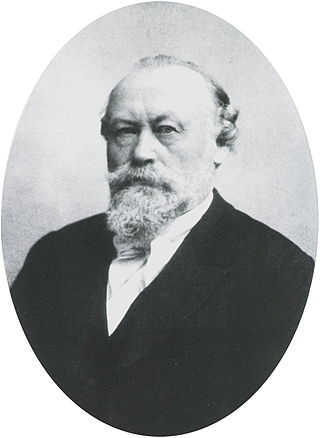Related Research Articles

Emil von Behring, born Emil Adolf Behring, was a German physiologist who received the 1901 Nobel Prize in Physiology or Medicine, the first one awarded in that field, for his discovery of a diphtheria antitoxin. He was widely known as a "saviour of children", as diphtheria used to be a major cause of child death. His work with the disease, as well as tetanus, has come to bring him most of his fame and acknowledgment. He was honoured with Prussian nobility in 1901, henceforth being known by the surname "von Behring."

Søren Peter Lauritz Sørensen was a Danish chemist, known for the introduction of the concept of pH, a scale for measuring acidity and alkalinity.

Cystine is the oxidized derivative of the amino acid cysteine and has the formula (SCH2CH(NH2)CO2H)2. It is a white solid that is poorly soluble in water. As a residue in proteins, cystine serves two functions: a site of redox reactions and a mechanical linkage that allows proteins to retain their three-dimensional structure.
The year 1907 in science and technology involved some significant events, listed below.
The year 1909 in science and technology involved some significant events, listed below.
The year 1888 in science and technology involved some significant events, listed below.
The year 1923 in science and technology involved some significant events, listed below.

Richard Adolf Zsigmondy was an Austrian-born chemist. He was known for his research in colloids, for which he was awarded the Nobel Prize in chemistry in 1925, as well as for co-inventing the slit-ultramicroscope, and different membrane filters. The crater Zsigmondy on the Moon is named in his honour.

Jacques Loeb was a German-born American physiologist and biologist.

Alexander Georg von Bunge was a Russian botanist. He is best remembered for scientific expeditions into Asia and especially Siberia.
Curt Theodor Schimmelbusch was a German physician and pathologist who invented the Schimmelbusch mask, for the safe delivery of anaesthetics to surgical patients. He was also a key figure in the development of mechanical methods of sterilisation and disinfection for surgical procedures, on which his Anleitung zur aseptischen Wundbehandlung was considered a seminal work.

Prof Eduard Friedrich Wilhelm Pflüger FRSFor HFRSE was a 19th-century German physiologist.

Wilhelm Robert Karl Anderson was a Russian-Estonian astrophysicist of Baltic German descent who studied the physical structure of the stars.
Johannes Adolf von Kries was a German physiological psychologist who formulated the modern “duplicity” or “duplexity” theory of vision mediated by rod cells at low light levels and three types of cone cells at higher light levels. He made important contributions in the field of haemodynamics. In addition, von Kries was a significant theorist of the foundations of probability.
Wilhelm Heinrich Heintz was a German structural chemist from Berlin.

Nikolai Aleksandrovich Menshutkin was a Russian chemist who discovered the process of converting a tertiary amine to a quaternary ammonium salt via the reaction with an alkyl halide, now known as the Menshutkin reaction.
The Gibbs–Thomson effect, in common physics usage, refers to variations in vapor pressure or chemical potential across a curved surface or interface. The existence of a positive interfacial energy will increase the energy required to form small particles with high curvature, and these particles will exhibit an increased vapor pressure. See Ostwald–Freundlich equation. More specifically, the Gibbs–Thomson effect refers to the observation that small crystals are in equilibrium with their liquid melt at a lower temperature than large crystals. In cases of confined geometry, such as liquids contained within porous media, this leads to a depression in the freezing point / melting point that is inversely proportional to the pore size, as given by the Gibbs–Thomson equation.

FriedrichWilhelm Zopf was a well-known German botanist and mycologist. He dedicated to his whole life with fungal biology, particularly in classification of fungi and dye production in fungi and lichens. Besides, his textbook on fungi called “Die pilze in morphologischer, physiologischer, biologischer und systematischer beziehung ” in 1890 was also an outstanding work on the subject for many decades. The unicellular achlorophic microalgae Prototheca zopfii is named after him because of his profound suggestions and contributions to Krüger's pioneering work in Prototheca. Thus, his numerous contributions gave him a special status in mycological history.
Ernst Hermann Riesenfeld was a German/Swedish chemist. Riesenfeld started his academic career with important contributions in electrochemistry by the side of his mentor Walther Nernst, and continued as a professor with work on the improvement of analytical techniques and the purification of ozone. Dismissed and prosecuted in Nazi Germany due to his Jewish origins, he emigrated to Sweden in 1934 and continued his ozone-related work there until retirement.

Géza Gusztáv Zemplén, Ph.D. was a notable Hungarian chemist, organic chemist, professor, and chemistry author. He was a recipient of the Kossuth Prize, a member of the Hungarian Academy of Sciences, and was the brother of Professor Győző Zemplén. His major field of research was structural chemistry and biochemistry including the synthesis of naturally occurring flavonoid-glycosides.
References
- ↑ Heape, Walter (1891). "Preliminary Note on the Transplantation and Growth of Mammalian Ova within a Uterine Foster-Mother". Proceedings of the Royal Society of London. 48: 457–8. JSTOR 115017 – via Biodiversity Heritage Library.
- ↑ Galton, Francis (1891). "The Patterns in Thumb and Finger Marks – On Their Arrangement into Naturally Distinct Classes, the Permanence of the Papillary Ridges that Make Them, and the Resemblance of Their Classes to Ordinary Genera". Philosophical Transactions of the Royal Society B . 182: 1–23. doi: 10.1098/rstb.1891.0001 . JSTOR 91733.
- ↑ Loeb, Jacques (1890). Der Heliotropismus der Thiere und seine Uebereinstimmung mit dem Heliotropismus der Pflanzen. Würzburg: Hertz. doi:10.5962/bhl.title.1663.
- ↑ Menschutkin, N. (1890). "Beiträgen zur Kenntnis der Affinitätskoeffizienten der Alkylhaloide und der organischen Amine". Zeitschrift für Physikalische Chemie . 5: 589.
- ↑ Menschutkin, N. (1890). "Über die Affinitätskoeffizienten der Alkylhaloide und der Amine". Zeitschrift für Physikalische Chemie. 6: 41. doi:10.1515/zpch-1890-0107.
- ↑ Fischer, Emil (1890). "Synthese des Traubenzuckers". Berichte der Deutschen Chemischen Gesellschaft. 23: 799–805. doi:10.1002/cber.189002301126.
- ↑ Muthmann, W. (1890). "Kürzere Originalmittheilungen und Notizen: Messlit, ein neues Mineral". Zeitschrift für Kristallographie, Kristallgeometrie, Kristallphysik, Kristallchemie (in German). 17. Akademische Verlagsgesellschaft.: 93–94.
- 1 2 Crilly, Tony (2007). 50 Mathematical Ideas you really need to know. London: Quercus. ISBN 978-1-84724-008-8.
- ↑ Waldman, Thomas A. (2003). "Immunotherapy: past, present and future" (PDF). Nature Medicine . 9 (3): 269–277. doi:10.1038/nm0303-269. PMID 12612576.
- ↑ "Schimmelbusch Mask". Park Ridge, Illinois: Wood Library-Museum of Anesthesiology. 2011. Retrieved 2013-03-19.
- ↑ British Patent 7146. "The Akroyd Oil Engine". Ray Hooley's – Ruston-Hornsby – Engine Pages. Archived from the original on 24 May 2011. Retrieved 2011-05-31.
- ↑ Crouch, Tom D. "Clément Ader". Encyclopædia Britannica . Retrieved 2011-03-03.
- ↑ Gray, Carroll (1998–2003). "Clement Ader 1841–1925". Flying Machines. Retrieved 2011-03-03.
- ↑ Gibbs-Smith, Charles H. (1959). "Hops and Flights: A Roll Call of Early Powered Take-offs". Flight . 75: 468. Retrieved 2011-03-03.
- ↑ "Copley Medal | British scientific award". Encyclopedia Britannica. Retrieved 23 July 2020.